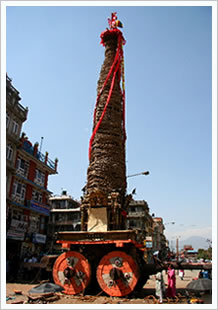
It is said about Nepal that every other structure is a holy shrine and every day a festival. For Nepalese, festivals are not merely the annual spectacles, but also are a living part of their rich cultural heritage. Festivals are an essential part of Nepalese life that garners tremendous local participation. They effectively bind together the Nepalese people of diverse cultural backgrounds and beliefs into one nation. They also offer visitors a valuable opportunity not only for having fun but gaining insight into various aspects of Nepalese culture. Most Nepalese festivals are related to different Hindu and Buddhist gods and goddesses and they are celebrated on such days consecrated them by religion and tradition. The religious festivals have fixed dates. Wherever or whenever you arrive in Nepal, you can be pretty sure of being at the right time for one or more special events. Some of the major and interesting festivals are presented below.
Nawavarsha/Nepali New Year (April)
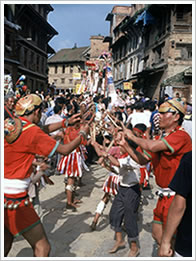 The Nepalese follow their own calendar system known as the Bikram Era or Bikram Sambat, which is accredited to King Bikramaditya. This festival celebrates the first day of the first month of the New Year and is observed as a National Holiday. On this occasion, “Bisket Jatra” is held in the city of Bhaktapur with an added importance. During Bisket Jatra, a tall wooden ceremonial poll is erected in one of the main squares. This festival commemorates the great battle of Mahabharata and the wooden pole symbolizes victory. After two days, images of the god Bhairab and his female counterpart Bhadra are enshrined in two large greatly decorated chariots and pulled through crowds of cheering on-lookers. When the chariot reaches the city center, a tug-of-war between the inhabitants of the two neighborhoods takes place. The winners of a tug-of-war are considered blessed with good fortune for the coming year. This festival goes on for nine days. Both Hindus and Buddhist celebrate it with a great pomp and show.
The Nepalese follow their own calendar system known as the Bikram Era or Bikram Sambat, which is accredited to King Bikramaditya. This festival celebrates the first day of the first month of the New Year and is observed as a National Holiday. On this occasion, “Bisket Jatra” is held in the city of Bhaktapur with an added importance. During Bisket Jatra, a tall wooden ceremonial poll is erected in one of the main squares. This festival commemorates the great battle of Mahabharata and the wooden pole symbolizes victory. After two days, images of the god Bhairab and his female counterpart Bhadra are enshrined in two large greatly decorated chariots and pulled through crowds of cheering on-lookers. When the chariot reaches the city center, a tug-of-war between the inhabitants of the two neighborhoods takes place. The winners of a tug-of-war are considered blessed with good fortune for the coming year. This festival goes on for nine days. Both Hindus and Buddhist celebrate it with a great pomp and show.
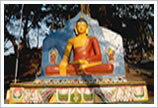 Buddha Jayanti/Baishakh Purnima (May)
Buddha Jayanti/Baishakh Purnima (May)
As Nepal is the birthplace of Lord Buddha, the light of Asia, the triple anniversary of the Buddha’s birth, enlightenment and death is observed with many colorful ceremonies on this day. People celebrate the occasion with great veneration paying homage to Buddha at places like Swayambhunath, Boudhanath and Lumbini.
Red Machhindranath Jatra (May/June)
 This festival is the biggest socio-cultural event of Patan. This festival is also known as Bunga-dyo Jatra. Bunga-dyo, is the Buddhist and as well as Hindu deity of rain. During this festival, Patan breaks out in color, music, dancing, and feasting in this month long religious revere and the year's biggest festival of the city. The deity's image is put in towering chariot and pulled by ropes through the narrow streets of the city followed by a large crowd of worshippers accompanied by a small crowd of traditional musicians adding even more excitement to the occasion. Over a period of several weeks, the chariot is slowly hauled to Jawalakhel where tens of thousands of devotees burn oil lamps and keep an all-night vigil. Rato (Red) Machhindranath month long journey comes to an end as the juggernaut lumbers into Jawalakhel for the final celebration. During the final day of chariot festival the "Bhoto" or sacred waistcoat, itself the subject of many legends, is displayed from the chariot. Astrologers determine this auspicious day. A final ritual is then conducted to mark Lord Machhindranath's departure for one year.
This festival is the biggest socio-cultural event of Patan. This festival is also known as Bunga-dyo Jatra. Bunga-dyo, is the Buddhist and as well as Hindu deity of rain. During this festival, Patan breaks out in color, music, dancing, and feasting in this month long religious revere and the year's biggest festival of the city. The deity's image is put in towering chariot and pulled by ropes through the narrow streets of the city followed by a large crowd of worshippers accompanied by a small crowd of traditional musicians adding even more excitement to the occasion. Over a period of several weeks, the chariot is slowly hauled to Jawalakhel where tens of thousands of devotees burn oil lamps and keep an all-night vigil. Rato (Red) Machhindranath month long journey comes to an end as the juggernaut lumbers into Jawalakhel for the final celebration. During the final day of chariot festival the "Bhoto" or sacred waistcoat, itself the subject of many legends, is displayed from the chariot. Astrologers determine this auspicious day. A final ritual is then conducted to mark Lord Machhindranath's departure for one year.
Gaijatra (August)
 In this festival teen-aged boys dressed up as cows, parade the streets of the town. This costume springs from the belief that cows help the members of the family who died within that year to travel to heaven smoothly. Some are also dressed up as an ascetic or a fool for achieving the same objective for their dead family members. Groups of mimics improvise short satirical enactment on the current social scenes of the town for the entertainment of the public. The week beginning from Janai Purnima actually unfolds a season of many good religious and cultural activities. All the Buddhist monasteries open their gates to the visitors to view their bronze sculptures and collection of painting for a week. At Patan, one observes the festival of Mataya at this time.
In this festival teen-aged boys dressed up as cows, parade the streets of the town. This costume springs from the belief that cows help the members of the family who died within that year to travel to heaven smoothly. Some are also dressed up as an ascetic or a fool for achieving the same objective for their dead family members. Groups of mimics improvise short satirical enactment on the current social scenes of the town for the entertainment of the public. The week beginning from Janai Purnima actually unfolds a season of many good religious and cultural activities. All the Buddhist monasteries open their gates to the visitors to view their bronze sculptures and collection of painting for a week. At Patan, one observes the festival of Mataya at this time.
The festivity of Gaijatra itself lasts for a week enlivened by the performance of dance and drama in the different localities of the town. Cultural centers, newspaper and magazines to fling humor and satire on the Nepalese Social and Political life are increasingly adapting the spirit of the old festival.
Krishnastamai (August/September)
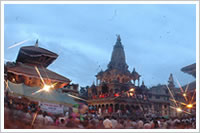 Krishnastamai or the birthday of Lord Krishna is celebrated in commemoration of the hero of the Hindu epic "Mahabharata". Lord Krishna taught warrior Arjuna the value of Karma in the Bhagwat Gita. He was born at midnight on the eighth day of the dark moon of August. To celebrate the birthday of this beloved Hindu god, worshippers carry ornate and decorate idols and pictures of Lord Krishna through the streets. Often bands of musicians follow or precede the procession, which is called as Shova Yatra. In Patan, thousands of devotees gather to Krishna Temple to worship and receive blessings. There, people from far away gather around the 17th century temple and wait for the midnight hour. Incantation and euphoric prayers fill the atmosphere along with the traditional music and small oil lamps are lit as mark of felicitation and devotion to the deity. The best place to watch the celebration of this festival is at the Krishna Temple in Patan.
Krishnastamai or the birthday of Lord Krishna is celebrated in commemoration of the hero of the Hindu epic "Mahabharata". Lord Krishna taught warrior Arjuna the value of Karma in the Bhagwat Gita. He was born at midnight on the eighth day of the dark moon of August. To celebrate the birthday of this beloved Hindu god, worshippers carry ornate and decorate idols and pictures of Lord Krishna through the streets. Often bands of musicians follow or precede the procession, which is called as Shova Yatra. In Patan, thousands of devotees gather to Krishna Temple to worship and receive blessings. There, people from far away gather around the 17th century temple and wait for the midnight hour. Incantation and euphoric prayers fill the atmosphere along with the traditional music and small oil lamps are lit as mark of felicitation and devotion to the deity. The best place to watch the celebration of this festival is at the Krishna Temple in Patan.
Teej (September)
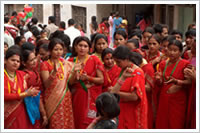 Teej is a festival of womanhood. This is a special festival for married women who are supposed to fast all day and bathe in the holy waters of the rivers. Dancing, folk songs and the red color sari that are worn by them on there wedding day dominate the day of Teej. Red is a symbol of joy and happiness in Nepal and the color used for marriage ceremonies. Married women are supposed to wear a lot of red. The days recall the heavenly occasion when Parvati, daughter of the Himalaya, won the hand of Lord Shiva after severe meditation and fasting.
Teej is a festival of womanhood. This is a special festival for married women who are supposed to fast all day and bathe in the holy waters of the rivers. Dancing, folk songs and the red color sari that are worn by them on there wedding day dominate the day of Teej. Red is a symbol of joy and happiness in Nepal and the color used for marriage ceremonies. Married women are supposed to wear a lot of red. The days recall the heavenly occasion when Parvati, daughter of the Himalaya, won the hand of Lord Shiva after severe meditation and fasting.
The first day of Teej is called the "Dar Khane Din". On this day women, both married and unmarried, assemble at one place, in there finest attires and start dancing and singing devotional songs. Amidst all this, the grand feast takes place. The jollity often goes on till midnight, after which the 24-hour fast commences.
The second day is for worship. The married ones ask for happy and productive marriage and a long life for their husband. Those yet to tie nuptial knots ask for a good husband. It is believed that their married life will be long and happy and they will not lose their husbands if they celebrate this festival. The entrance to Pashupatinath Temple is a good place to watch as crowds of women come down to the river, dressed in brightly colored saris with red marks on their foreheads.
Rishi Panchami falls on the third day of Teej. On this day, the seven Rishis (Sages) of the Hindu pantheon are worshipped by women to cleanse all sins of the previous year. Sages are the symbol of the purity of religion and holy practices in this earth. On this day women clad in red dress descend to the holy Temple of Lord Pashupatinath to pray to Lord Shiva. Women clean their teeth and bathe at the holy rivers especially at the Bagmati River near the Temple of Pashupatinath.
Indrajatra (September)
 This Festival is in honor of the ancient Aryan deity Indra, Lord of Heaven, who gave the monsoon rain to the valley farmers, marks the end of the monsoon and the beginning of the best season of the year. Both Hindus and Buddhists celebrate this festival with great enthusiasm. The festival continues for eight days during which there is much rejoicing, dancing and feasting. On the first day, a long wooden pole is erected in front of the ancient Royal Place at Hanuman Dhoka, in order to propitiate Indra, the god of rain. Classical dancers also assemble at the spot wearing different kinds of masks and dancing around the courtyard of Hanuman Dhoka to celebrate Indra's visit. On the third day of the festival, the Living Goddess or "Kumari" is taken out in a procession through the streets of Kathmandu. Three chariots of Kumari, Ganesh and Bhairab are taken round the city for three days. In this festival many other interesting dances including the Mahakali, Mahalaxmi and Dasha Avatara masked dances, which are staged on the plinth of Narayan Temple, just opposite the Kumari Temple. On the last evening of the festival, the long wooden pole erected on the first day is lowered amid religious ceremonies and animal sacrifices. The image of White Bhairab, one of the fierce manifestations of Shiva is unveiled for three days each year during this festival at Kathmandu Durbar Square and the Indrachowk area.
This Festival is in honor of the ancient Aryan deity Indra, Lord of Heaven, who gave the monsoon rain to the valley farmers, marks the end of the monsoon and the beginning of the best season of the year. Both Hindus and Buddhists celebrate this festival with great enthusiasm. The festival continues for eight days during which there is much rejoicing, dancing and feasting. On the first day, a long wooden pole is erected in front of the ancient Royal Place at Hanuman Dhoka, in order to propitiate Indra, the god of rain. Classical dancers also assemble at the spot wearing different kinds of masks and dancing around the courtyard of Hanuman Dhoka to celebrate Indra's visit. On the third day of the festival, the Living Goddess or "Kumari" is taken out in a procession through the streets of Kathmandu. Three chariots of Kumari, Ganesh and Bhairab are taken round the city for three days. In this festival many other interesting dances including the Mahakali, Mahalaxmi and Dasha Avatara masked dances, which are staged on the plinth of Narayan Temple, just opposite the Kumari Temple. On the last evening of the festival, the long wooden pole erected on the first day is lowered amid religious ceremonies and animal sacrifices. The image of White Bhairab, one of the fierce manifestations of Shiva is unveiled for three days each year during this festival at Kathmandu Durbar Square and the Indrachowk area.
Dashain (September/October)
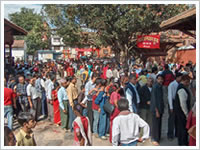 It is truly the national festival of Nepal. Every Nepali is stirred by the prospects of joy that this festival is supposed to bring with it. The change of mood is also induced psychologically by the turn of autumn season after a long spell of monsoon, introducing clear and brilliant days, an azure blue sky and a green carpet of fields, the climate is also just ideal at this time, it is neither too cold nor too warm. The Nepalese cherish their Dashain as time for eating well and dressing well. Each house sets up shrine to worship the Goddess at this time. Barley seeds are planted on the first day in every household and nurtured for nine days. During this period Goddess Durga Bhawani is worshipped and offered a lot of blood sacrifices. Buffaloes, goats, chickens and ducks are killed by the thousands at the temples, at military posts, and in every household. One of the main centers that witnesses the animal sacrifice in a large scale at this time is the Hanuman Dhoka Palace on the ninth. On the concluding day of the festival called the Tika, the elders of the family give Tika to their junior members and to other relatives who may also come to seek their blessings. The fresh shoots of the barley's are also given. Family feasting and feeding of guests is a common practice at this time.
It is truly the national festival of Nepal. Every Nepali is stirred by the prospects of joy that this festival is supposed to bring with it. The change of mood is also induced psychologically by the turn of autumn season after a long spell of monsoon, introducing clear and brilliant days, an azure blue sky and a green carpet of fields, the climate is also just ideal at this time, it is neither too cold nor too warm. The Nepalese cherish their Dashain as time for eating well and dressing well. Each house sets up shrine to worship the Goddess at this time. Barley seeds are planted on the first day in every household and nurtured for nine days. During this period Goddess Durga Bhawani is worshipped and offered a lot of blood sacrifices. Buffaloes, goats, chickens and ducks are killed by the thousands at the temples, at military posts, and in every household. One of the main centers that witnesses the animal sacrifice in a large scale at this time is the Hanuman Dhoka Palace on the ninth. On the concluding day of the festival called the Tika, the elders of the family give Tika to their junior members and to other relatives who may also come to seek their blessings. The fresh shoots of the barley's are also given. Family feasting and feeding of guests is a common practice at this time.
Tihar/Dipawali (October/November)
After Dashain, Tihar is probably Nepal's second most important festival, which is known as "The festival of lights". This festival is a time of lights and tinsel decoration, fancy sweets and juicy fruits. The first day the, crows are worshipped. They are also known as the "Messenger of Death". Crows are honored and fed on leaf dishes. Incense and light are also lit. In the early morning, after the ritual bath, the first portion of every family meal is offered to crows.
The second day is known as the dog's day. On this occasion dogs, the vehicle of Lord Bhairab, are given a red Tika on their foreheads and garlanded with flowers. They are then worshipped and offered goodies, including many delicacies.
The next day is the day of cow, representatives of Laxmi, the Goddess of Wealth and Prosperity. This day is an even more important day, as Laxmi Puja also falls on this day. Towards the evening, small candles or rows of wick lamps are lighted and placed outside the main door and along window sills, with a strong hope that Laxmi pleases to reside in light. This becomes a very beautiful spectacle as the whole city and village become filled with little lights. The day is popularly called as Dipawali (Diwali) and is also an occasion for gambling.
The fourth day is bit different. On this day, the things that are worshipped depend on the specific cultural background. Normally most of the people perform 'Goru Puja', ox worshipping. The ox is worshipped with Tika, garland and delicious meal. On the other hand, people who follow lord Krishna perform 'Gobhardan Puja'. These people build a small hill made out of cow dung and put some grass on it then do puja on it. This puja symbolizes the act of Lord Krishna when he lifted the Gobhardan Hill and saved millions of people and cows from floodwater. 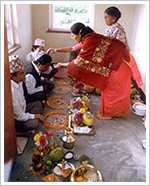 People belonging to the Newar community perform 'Mha Puja' which literally means worshipping yourself. The Newar community people are worshipping life by doing puja on themselves.
People belonging to the Newar community perform 'Mha Puja' which literally means worshipping yourself. The Newar community people are worshipping life by doing puja on themselves.
Brother's day or Bhai Tika is the fifth and final day of Tihar. On this day, every sister worships her brothers and prays to Yama, the god of Death, for their brothers' progress, prosperity and longevity. Sisters' put multi-colored Tika on the brother's forehead and garlands them with flowers. The brothers are offered many delicacies including sweets, fruits etc. as well as her blessings. The brothers then in turn give Tika to their sisters after which gifts are also exchanged. As with many other festivals, Tihar ends with a grand feast with all family members present.
Mani Rimdu (October/November)
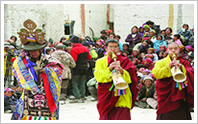 The Sherpas hold Mani Rimdu high in their hearts, for it is the greatest annual festivity observed in the Khumbu area. Sherpas from the Khumbu region, and even tourists from far-away places, congregate for the three-day celebration that starts from the first day of the tenth month of the Tibetan Lunar calendar which falls between mid-October to mid-November. It depicts the victory of Buddhism over the ancient 'Bon' religion. The ceremonies start with the blowing of horns by Buddhist monks in the afternoon of the first day. Then the chief Lama, accompanied by other monks in their maroon robes, arrives on the stage. Prayers are chanted and gratitude is extended to all those who have contributed, both monetarily and materially, for the function. The crowd then rises up to their feet to receive blessings, holy water and auspicious pellets from the Lama for good luck and longevity. An orchestra of cymbals, horns, flutes and conch shells announces the start of the second day's celebrations. Then follow the masked dances in which monks in colorful robes and huge glowering masks perform routines symbolizing the destruction of evil forces.
The Sherpas hold Mani Rimdu high in their hearts, for it is the greatest annual festivity observed in the Khumbu area. Sherpas from the Khumbu region, and even tourists from far-away places, congregate for the three-day celebration that starts from the first day of the tenth month of the Tibetan Lunar calendar which falls between mid-October to mid-November. It depicts the victory of Buddhism over the ancient 'Bon' religion. The ceremonies start with the blowing of horns by Buddhist monks in the afternoon of the first day. Then the chief Lama, accompanied by other monks in their maroon robes, arrives on the stage. Prayers are chanted and gratitude is extended to all those who have contributed, both monetarily and materially, for the function. The crowd then rises up to their feet to receive blessings, holy water and auspicious pellets from the Lama for good luck and longevity. An orchestra of cymbals, horns, flutes and conch shells announces the start of the second day's celebrations. Then follow the masked dances in which monks in colorful robes and huge glowering masks perform routines symbolizing the destruction of evil forces.
Bibah Panchami (November/December)
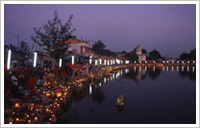 In the Hindu tradition, the love story of Lord Ram, the epic hero of the Ramayan, and Sita, model of ideal Hindu womanhood is considered as holy and greatest. This festival, taking place in Janakpur in the eastern Terai, celebrates the marriage of Lord Ram and Sita. During the week before the festival starts, thousands of pilgrims start to arrive in the historic city of Janakpur to observe and take part in the re-enactment of the marriage procession. The celebrations are focused around the Janaki Temple and the Ram Sita Bibah Mandap. On the first day of the festival, a large procession sets out from Ram Temple, carrying an image of Ram and proceeding to the famous Janaki Temple. The next day, in an equally colorful ceremony, an idol of Sita is carried to Ram's side thus re-enacting the ancient wedding of the divine couple.
In the Hindu tradition, the love story of Lord Ram, the epic hero of the Ramayan, and Sita, model of ideal Hindu womanhood is considered as holy and greatest. This festival, taking place in Janakpur in the eastern Terai, celebrates the marriage of Lord Ram and Sita. During the week before the festival starts, thousands of pilgrims start to arrive in the historic city of Janakpur to observe and take part in the re-enactment of the marriage procession. The celebrations are focused around the Janaki Temple and the Ram Sita Bibah Mandap. On the first day of the festival, a large procession sets out from Ram Temple, carrying an image of Ram and proceeding to the famous Janaki Temple. The next day, in an equally colorful ceremony, an idol of Sita is carried to Ram's side thus re-enacting the ancient wedding of the divine couple.
Makar Sankranti (January)
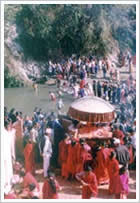 Makar Sankranti sees the religious ceremonies throughout the country to mark the sun's northward journey. There are usually fairs at the confluence of major rivers during the first day of the month according to the Nepalese calendar when people take bath in the holy rivers. The festival witnesses special celebration at the Devghat River confluence, near the Royal Chitwan National Park, where the Trisuli and Kali Gandaki rivers meet. It is celebrated according to the solar calendar and occurs in mid-January. On this day devotees pay obeisance to Lord Shiva and other Hindu deities.
Makar Sankranti sees the religious ceremonies throughout the country to mark the sun's northward journey. There are usually fairs at the confluence of major rivers during the first day of the month according to the Nepalese calendar when people take bath in the holy rivers. The festival witnesses special celebration at the Devghat River confluence, near the Royal Chitwan National Park, where the Trisuli and Kali Gandaki rivers meet. It is celebrated according to the solar calendar and occurs in mid-January. On this day devotees pay obeisance to Lord Shiva and other Hindu deities.
Lhosar (January/February)
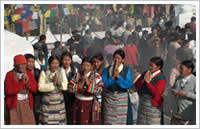 This festival is most impressively observed in the month of January/February by the Sherpas. They organize folk songs and dances on this occasion. These dances can be seen in Khumbu, Helambhu and other northern regions of Nepal and also at Boudhanath in Kathmandu. The festival is essentially a family affair when friends and member of the family get together.
This festival is most impressively observed in the month of January/February by the Sherpas. They organize folk songs and dances on this occasion. These dances can be seen in Khumbu, Helambhu and other northern regions of Nepal and also at Boudhanath in Kathmandu. The festival is essentially a family affair when friends and member of the family get together.
Maha Shivaratri (February/March)
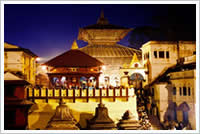 This is the most famous and celebrated festival of Nepal, which attracts large crowds from far-flung places both in India & Nepal. This is the grandest and prominent festival among the numerous festivals, which is consecrated in honor of Lord Shiva, the God of Destruction. In Hinduism, he is one of the supreme trinity. On the morning of Shivaratri day and on proceeding days, thousands of worshippers throng Shivas' Temple, but the temple of Pashupatinath in Kathmandu holds the greatest attraction of all. One gets to see thousands of Hindu devotees coming to visit the temple of Pashupatinath. Among them are a large number of Sadhus and Naked ascetics. Many people like to keep awake for the whole nights keeping vigilance over an oil lamp burnt to please Lord Shiva. Children are seen keeping awake similarly over a bonfire in many localities. In the afternoon an official function is held to celebrate this festival at Tundikhel. The Nepalese Army organizes a show in which series of gunfire are sounded.
This is the most famous and celebrated festival of Nepal, which attracts large crowds from far-flung places both in India & Nepal. This is the grandest and prominent festival among the numerous festivals, which is consecrated in honor of Lord Shiva, the God of Destruction. In Hinduism, he is one of the supreme trinity. On the morning of Shivaratri day and on proceeding days, thousands of worshippers throng Shivas' Temple, but the temple of Pashupatinath in Kathmandu holds the greatest attraction of all. One gets to see thousands of Hindu devotees coming to visit the temple of Pashupatinath. Among them are a large number of Sadhus and Naked ascetics. Many people like to keep awake for the whole nights keeping vigilance over an oil lamp burnt to please Lord Shiva. Children are seen keeping awake similarly over a bonfire in many localities. In the afternoon an official function is held to celebrate this festival at Tundikhel. The Nepalese Army organizes a show in which series of gunfire are sounded.
Fagu Purnima/Holi (March)
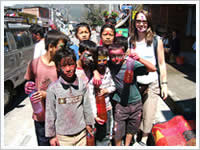 This festival, which is also known as "The Festival of Colour and Rejoice", occurs in the springtime on the day of the full moon in the Nepalese month of Falgun. It marks the demise of the demoness Holika by the hands of Lord Bishnu. Smearing color and throwing colored powder at each other marks the occasion.
This festival, which is also known as "The Festival of Colour and Rejoice", occurs in the springtime on the day of the full moon in the Nepalese month of Falgun. It marks the demise of the demoness Holika by the hands of Lord Bishnu. Smearing color and throwing colored powder at each other marks the occasion.
In Kathmandu at Durbar Square a ceremonial pole, known as "Chir", is set up which announce the beginning of the festival. Chir is a long pole whose upper portion consists of wooden frames decorated with strips of colorful cloth. At the end of the festival, the Chir is taken down and burnt.
Ghodejatra (March/April)
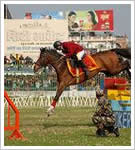 Ghodejatra, the festivals of horses, is a yearly sports event taking place at the Tundikhel parade ground in central Kathmandu. Its roots go several hundred years, though it is also associated with older religious traditions. At midnight as the parade grounds, the images of Bhadrakali and her sister goddess are carried from their respective temples and placed in the middle of the dark expanse. A third sister goddess is then brought from another locality and made bow before the first two images.
Ghodejatra, the festivals of horses, is a yearly sports event taking place at the Tundikhel parade ground in central Kathmandu. Its roots go several hundred years, though it is also associated with older religious traditions. At midnight as the parade grounds, the images of Bhadrakali and her sister goddess are carried from their respective temples and placed in the middle of the dark expanse. A third sister goddess is then brought from another locality and made bow before the first two images.
The actual horse- racing is conducted with great gusto and spectators come from all over the valley as well as from more distant, to witness the exciting event.
|